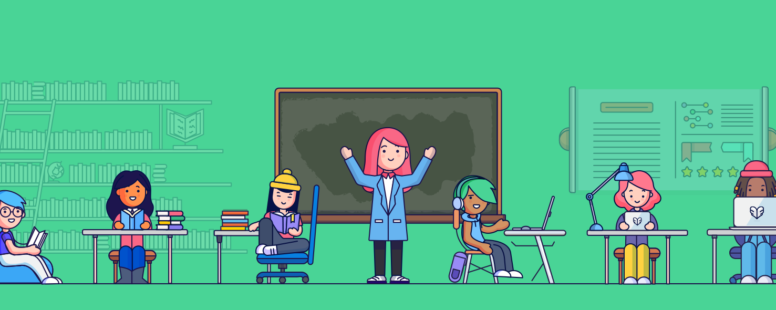eBooks : Print – This shouldn’t be an either/or discussion
Christophe Spy/ July 31, 2020/ Classroom Tips, eBooks, ELA, K-12, Literacy Coach/ 0 comments
Three considerations for using texts in the classroom this year
By: Samantha Reichard
In my first year as an ELA teacher, “read a book” became my calling card. When someone finished their assignment early, or feigned the necessity to leave the classroom to ‘get something’ from the office, they expected me to redirect them to “read a book.” My goal was to reinforce to my non-reading 8th graders the importance of reading not just because it was part of the curriculum, or to just pass the time, but because reading was (and is) a pathway to answers throughout our lives.
Consequently, it was on me to deliver reading choices and formats that suited their needs and interests. The typical thirteen-year old is not wired to select a book and sit down reading, especially when confronted with so many distractions built into their phones. But even with the rise of technology, my classroom bookshelf was carefully manicured and labeled over ten years to include a diverse selection of texts spanning several genres. My goal was simple – if I tell a kid to read a book, I need to give that kid a book to read.
As we prepare for the 2020-2021 school year, I find myself wondering not only about the shifts teachers must take this year, but also if our bookshelves will be ready for what lies ahead. With Covid-19 threatening everyone and every routine we’ve held dear, is it necessary for us to look beyond paper texts towards a more resilient method in cultivating the love of reading: digital reading? Or should ebooks versus print not be an either/or discussion? Let’s look at three considerations in deciding how our texts will make-the-cut in all classrooms this year:
Consideration 1: Accessibility
What is readily available for students should be what is most appropriate to use. Paper books and mentor texts are currently living in classrooms and within the classroom are extremely accessible; they can be easily given out during class and taken back in at the end of the lesson, and may only require a few copies per lesson. Paper books also give readers the full experience of traditional reading: turning and smelling the pages and the weight of the text in hand.
Traditional texts may not be as accessible, however, if students are going to be at-home learners through virtual or hybrid learning models. It will be difficult to distribute novels to each home and procedures for distribution and collection will be a logistical nightmare for teachers. Also, using paper texts within the classroom can be a sanitation hazard. In an article from the Journal of Hospital Infection, “NCPTT states the virus can live on paper four to five days and on plastics for up to nine days,” and would require a period of detoxification until they can be used safely again.
Here’s where ebooks come in.
Digital reading encourages our educational stakeholders to maintain best reading practices because they are accessible and flexible for anyone with any type of electronic device.
Ebooks can’t go out of stock, students won’t have to risk going to distribution sites, libraries, or stores to find their reading material, and can be purchased and uploaded within seconds. Some education-focused digital reading platforms, including Glose, provide the ability to read texts offline, which can overcome disparities within communities that don’t have ubiquitous connectivity.
As I reflect on my “read a book” mantra, it’s clear to me that having ebooks as a readily available option is the only way I can fulfil my obligation to ensure every kid has a book to read.
Consideration 2: Active Participation
To instill a love of reading in students, teachers give mini-lessons on many different strategies for interacting with – and enjoying – literature. One of my most trusted exercises for engagement was to create before, during, and after reading questions and illustrations on folded paper that students would use to stay engaged throughout their reading. For more rigorous assignments, my students were taught to annotate the text and make constant connections between themselves, other texts, and situations they know about. With paper-based texts, this form of learning can still take place. Sticky notes in the margins with gists, connections, and questions are effective tools for student engagement with texts. My favorite sight is a well-worn book that’s been dogeared, post-it-noted, and annotated because it’s a sign that a highly-engaged reader has interacted with its contents.
As we move into this new era of teaching and learning, we must carry with us the long-standing practice of engaging readers. And, given the fluid nature of our upcoming school year, we have to be ready for reading engagement no matter what comes next; enter digital reading and ebooks. Digital reading embeds many tools students and teachers can use to interact with the text. In the study, “Student Engagement with E-Texts: What the Data Tells Us” researchers found that “…higher engagement with e-texts (reading and highlighting) correlated with higher course grades” (Abasi, Quick, Marrone 2017).
When students can highlight words and phrases to emphasize sections, discover a definition, or translate into 100+ different languages, all in one platform, students are set up for higher levels of mastery.
With paper books, one would have to stop reading entirely to pull out a resource (digital or paper) to define or translate the unknown word. Student’s won’t have to stop reading to uncover meaning – they are actively participating within the text to deepen their understanding and therefore less likely to skip over those demanding sections. And, in the case of Glose, teachers can see which words and phrases students are looking up and use this information to build highly relevant vocabulary and comprehension activities, just one example of how we as teachers can use engagement to drive deeper learning.
Reading is a conversational connector at its core, and we can not only recreate these experiences while at home, but amplify them with questions and annotations right into a reading-based social media news feed. Digital reading with Glose allows for engaging activity that builds upon schema and connectivity of social media, something that is a mainstay in our students’ lives. Teachers can begin their work with being culturally relevant educators when they embrace new platforms for facilitating reading. Imagine class discussions where students can comment on their connections with what they are reading, use reaction emojis right within the text, and continue discussions with peers through commenting on posts showing up in their news feed. While my love for paper books will never waiver, I can’t help thinking that this kind of interaction is going to meaningfully redefine what engagement looks like – for the better – in the 2020-2021 school year and beyond.
Consideration 3: Accountability
This last consideration is teacher-focused. I have used reading logs (paper and digital) to track which books my students were reading completely or just ‘tasting’, how long it would take a student to read the book, and to identify trends in the types of books chosen by the student. This is an effective method with paper books so teachers can hold students and themselves accountable for continually providing a stream of interesting content within the classroom.
When we move this reading online, however, or have to quickly pivot from in-class to hybrid learning scenarios, there are many tools that are directly embedded in the reading experience that provide teachers with more authentic and accurate data. Instead of relying on students to remember to track each text accurately, ebook platforms for education provide an embedded reading log for every student, allowing their teachers incredible insight into whether and how each student is engaging with the text.
Teachers can use analytics to see how many texts their students have chosen to have read or sample, how many pages they have read (over what period of time),how they have interacted with the text, and even which words have been defined or translated.
This data is delivered in real-time so that teachers can offer in-the-moment support to the class as needed and make changes within the lesson to support language acquisition and reading comprehension.
The term “new school year” has a different meeting for 2020-2021, in that much of how we engage learners will be new. This is an important opportunity for ELA teachers and curriculum leaders to assess what will work based on what we currently have and also evaluate how new technologies, like education-specific ebook platforms, can help us do our jobs better. One way or another, when kids ask me a question I still plan on saying “read a book.” And one way or another, I’m going to give them a book to read. Whereas I used to pull a book from my shelf and hand it to them, I’ll likely click a button and instantly load it to their personal ebook shelf. Whatever it takes is what I’m going to do, and that’s okay by me.

About the Author
Samantha Reichard serves as Lead Real Time Teacher Coach for Center City 1 Learning Community in Charlotte, NC, serving as a mission-critical resource for 29 inner-city and Title I schools in the Charlotte Mecklenburg School District. After graduating from the State University of New York at Fredonia, Samantha began her teaching career at East Union Middle School in Union County, NC as an eighth-grade English language arts teacher. After two years, she moved to Charlotte, NC and served as a sixth- and seventh-grade language arts teacher for five years before becoming a multi-classroom leader and real-time teacher coach. Following that, she worked on expanding the model of Multi-Classroom Leader and Real-Time Teacher Coaching (RTTC) for four years at Ranson IB Middle School.
